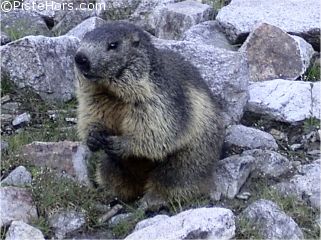
The life or at least the life style of one of the cutest animals living in the mountains is potentially threatened in the Hautes-Alpes due to a birth control test being carried out near the ski resort of Orcières. Marmottes or Ground Hogs, these fluffy animals which sleep all winter and come out in the spring to breed and enjoy some sunshine, have been accused by some of damaging the fields in the national park of the Ecrins by digging holes and moving stones.

Marmottes have until now been very well organised. Each family is usually composed of 2 to 20 animals, with a dominant male and a dominant female. The male and female are usually faithful to each other, the females breeding once a year, giving birth to up to four babies or marmottons.
The increasing number of marmottes in some areas of the Hautes Alpes and the damage they allegedly cause led the authorities to attempt to control the birth rate. In the valley of Prapic 40 of the 160 marmotte population have been injected in the spring to decrease their ### drive. Early July, when marmottons usually come out of their parents’ burrow, scientists will find out whether their scheme has worked.
These scientific tests raise a number of issues.
Firstly we shouldn’t forget that marmottes have lived in the mountains for as long as - if not longer - than humans. They have helped create the mountains as they are now by digging holes and moving stones. Is this scheme not going against the laws of nature? Events show (with global warming partly generated by industry) that the changes we brought to nature in the past did not always prove positive.
Secondly don’t we run the risk of affecting a long existing species of animals and eventually destroying them? Marmottes are well organised and hard working animals devoted to their families. The injections of hormones to the males of the community are likely to reduce their willingness to work, protect their families as well as reproduce. Although it is difficult at this stage to assess the effects this could have on the mountains and their wild life, is it worth taking the risk of changing it?